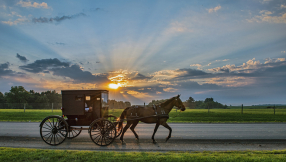
What is probably the world’s first recorded successful women’s rights campaign is in the Bible. Here is the story ...
Zelophehad
Zelophehad was the son of Hepher, son of Gilead, son of Machir, son of Manasseh, who was one of the two sons of Joseph (Numbers 27:1). Zelophehad, along with the other Israelites, had left Egypt with Moses. He had a wife and they had five daughters and no sons. The Bible doesn’t usually record the names of daughters unless they are very significant, and all five of his daughters are named. They were called Mahlah, Noa, Hoglah, Milcah and Tirzah and they had been born during the Exodus (Numbers 26:33), and before Zelophehad died in the wilderness. They were all unmarried when their father died so we can assume they were quite young.
Background
Our story is set when the Israelites were in exile for forty years after the Exodus. The Promised Land had been spied out, and the Israelites were gathered on the plains of Moab across the River Jordan. At this point Aaron has died (Numbers 33:38), but Moses is still alive. The land was apportioned according to the names of the men in the census, as recorded in the book of Numbers. Only men over the age of twenty were counted in the census (Numbers 1:45-46), because it was taken as a muster for military service. Zelophehad’s daughters
In the early days, women could not inherit. So, when Zelophehad died sonless (Numbers 36:13) leaving his widow and five daughters with nothing, they felt this was unfair because they wanted to inherit their father’s property, which otherwise would have gone to a male cousin. The Bible records their determination because “they stood before Moses and before Eleazar the priest and before the chiefs and all the congregation, at the entrance of the tent of meeting” (Numbers 27:2). Perhaps encouraged by their mother, they spoke boldly and explained the injustice of the situation before Moses and Eleazer, who was now High Priest after the death of his father Aaron (Numbers 20:28).
The five daughters explained that Zelophehad had been loyal to Moses and had not taken part in Korah’s rebellion (Numbers 27:3). They asked: “Why should the name of our father be done away from among his family, because he had no son?” (Numbers 27:4, KJV) and Moses “brought their case before the LORD” (Numbers 27:5, KJV).
As a result, it was agreed that not only could they inherit, but in addition the anomaly in the Mosaic law was changed so that: “If a man die, and have no son, then ye shall cause his inheritance to pass unto his daughter” (Numbers 27:8, KJV). Indeed, we read that later they did receive their inheritance and they married relatives within their own tribe (Number 36:12). They inherited land in the Promised Land (Joshua 17:3-6), within “Manasseh’s share” which “consisted of ten tracts of land besides Gilead and Bashan east of the Jordan” (Joshua 17:5 NIV).
Female inheritance
The story of Zelophehad’s daughters established two fundamental Jewish theological principles. It established the precedent that the Mosaic law can be challenged and changed. It also established that women could inherit as well as men, and therefore inheritance, including the royal throne, could go down the female line. It is not the only case of female inheritance in the Bible, because we read that Job gave inheritance equally to his sons and his daughters (Job 42:15). Later we also read of Achsah, daughter of Caleb, who married Othniel who became the first of the Judges (Judges 3:9-11). She requested and received an inheritance of land in the Negev and water resources from her father (Judges 1:9-15).
Afterlife of the story
The story of Zelophehad’s daughters played a theological and political role in English and Scottish history, during debates about royal succession to the throne.
In the 1140s, the story of Zelophehad was quoted to back up the claim for Matilda, only surviving child of King Henry I, to inherit the English throne. Henry I had named Matilda as his heir. Some people consider Matilda to be the first ruling queen of England from 1141-48, although Matilda was never formally crowned and instead was known as the “Lady of the English”. The throne was taken by her cousin Stephen de Blois, but Matilda’s son succeeded to the throne as Henry II in 1154.
A few centuries later in England, the story paved the way for the Tudor princesses Mary and Elizabeth to be heirs after the death of their brother Edward VI, with the accession of Queen Mary I in 1553, and later Queen Elizabeth I in 1558.
Meanwhile in Calvinist Scotland, the story of Zelophehad’s daughters was quoted in debates about whether it allowed King James V’s only child Princess Mary to become queen, which she later did as Mary Queen of Scots in 1564. Then when James VI inherited the Scottish throne, it was through the female line as daughter of Mary, Queen of Scots. When he inherited the English throne as James I it was also through the female line as the great-grandson of Mary Tudor, daughter of Henry VII who had married James V of Scotland.
Modern echoes
You may be aware of the plot in a modern adaptation, because the story of Zelophehad’s daughters has influenced literature, where it has been retold in modern settings.
Jane Austen picks up the idea in her book ‘Pride and Prejudice’, published in 1813. Mr Bennet is a modern Zelophehad, who inherited his estate under a legal entail which stated he could only leave the estate to a male relative. That was not a concern at first, because he presumed to have a son who would one day inherit. However instead, echoing the story of Zelophehad, the plot revolves around the fact that he had five daughters, called Jane, Mary, Catherine, Lydia, and Elizabeth, who could not inherit.
The idea of a man with five daughters and no son, is also used as a theme in the story ‘Fiddler on the Roof’. In 1964, this was made into a successful musical based on the book by Joseph Stein which is set in or about 1905. The fiddler is a pious Jewish dairyman called Tevye living near Kiev in the Ukraine. He has five daughters called Tzeitel, Hodel, Chava, Shprintze and Bielkewho, who each need a dowry.
Read the story
This story is over 3,000 years old and is most probably the world’s oldest story of a successful women’s rights campaign. The story of Zelophehad’s daughters is not well-known in many traditional Church traditions, because it does not appear in the lectionary, but it is important theologically. If you are not familiar with the inspiring story of Zelophehad’s daughters you can read it in Numbers 27:1-11 and Joshua 17:3-6.









